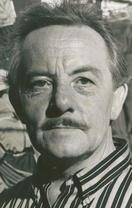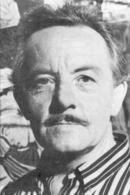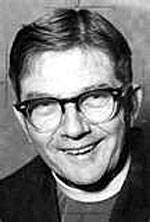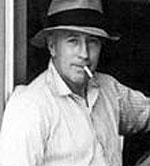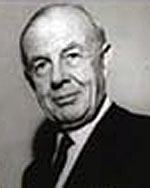All the information contained on this website is from Jean's personal correspondence with his patrons & family,
collated by Noel and Rachael Orval.
 | ||||||
Bishop Felix Arnott, Appointed Co-Adjutor Bishop of Melbourne 1963
6th Arch Bishop of Brisbane in July 1970, retiring in July 1980
"Thank you for the glass panel of the loaves and fishes, which I found awaiting me in my
office when I came into the cathedral this morning. It is a charming design, beautifully
executed and I love the colours of it, and will treasure it for "its theme and artistry, as well
as its association with you." Thank you very much indeed for such a beautiful gift. Anything
more I can do to help you and encourage wider use of your work will be my pleasure."
Jean and Bishop Arnott had a long standing friendship and Bishop Arnott appreciated greatly the fact that Jean wrote to him in frankness, with which he offered Jean advice and encouragement to continue in his craft when Jean felt an indifference from certain clerics regarding his style. Bishop Arnott wrote, "The position of a truly creative artist is always difficult in our materialist culture and so few people in Australia have any real appreciation of the true relationship that exists between the church and the artist. You must not allow yourself to be discouraged by the ignorance or prejudices of clergy, whether Catholic or Anglican, or of their lay readers. People have been fed for so many years on the mass produced art of the Catholic Emporia or of firms like Brooks Robinson. All my friends who have seen your work have admired it. Do not lose heart. My good wishes and prayers are with you. Again, I am glad you wrote to me as you did and I apologise for the crass stupidity of some of our Clergy." Bishop Arnott presided over many of the dedications in Melbourne including St John's Anglican in Blackburn, St George's Anglican, Malvern and recommended Jean to various others including the Memorial Committee of the Grimwade House Chapel at Melbourne Grammar, for which Jean completed 3 windows.
Whilst Jean was in Australia, he was sought by many eclectic organisations to exhibit his works. Although Jean always said that this wasn't a venue to make huge sums - he believed that Australia is probably the only country in the world where an artist can make a name for himself, and still starve - Jean felt that our young country needed to be introduced to a new art culture which was sadly lacking. After all "the Continent had thousands of years to learn arts and crafts, and here only 200 years." He always found it a tremendous battle, simply because he was the master of a craft that in Australia, had little symbolic or architectural value in homes, and was only sought for ecclesiastical commissions. In Europe, it is common for stained glass to be incorporated into housing - just as important a decision as to what structure should be used.
Ballarat - July, 1958:
Sister Margaret Mary of the Convent of Mercy, Ballarat wrote Jean to say what a wonderful success their exhibition was. "I do appreciate the
trouble and risk you took to lend us so much valuable work and to get it here. It was very much admired. The Warrnambool nuns recognised
your name and had some very nice things to say about you. Mr Gleeson and some artist friends were here and he was very pleased your work
was on show. I can assure you, many more people know your work now and are very interested in it."
Hamilton - May 14-25, 1962:
Jean presented stained glass and opaline glass at this exhibition at the Hamilton Art Gallery, and left many people in awe of his talents and
craftsmanship. Fr Tom Luby wrote "... I have to give a Retreat in Melbourne and one of the regrets I have is that I will not be able to make
many more visits to the display of your work. I would like to add my voice to the congratulations you must be receiving. I can't remember ever
getting such pleasure from an exhibition and I sincerely hope that you get the recognition this work deserves." John Ashworth, Hamilton
Gallery's first director said, "that most stained glass window craftsmen were concerned only with the design of their work. Mr Orval has done
the lot. Even down the hand casting of the lead, which is usually done at a factory."
Melbourne - September, 1962:
The Arts & Crafts Society of Victoria held their Annual Exhibition at the Lower Town Hall in Melbourne - an affair that was opened by Sir Daryl
Lindsay. Assistant Secretary J. Smith said that "you should be invited to exhibit your stained glass at our Annual Exhibition. Mrs Brent Clark
who visited you last week, spoke very highly of your work."
When the Exhibition had finished, President Joan Lindsay said "it was unanimously agreed by all, that your display at the Exhibition has caused
a great deal of interest to our members and the general public. As you know, my husband was instrumental in making a purchase from you, on
behalf of the Government." Sir Daryl Lindsay penned a thank you letter to Jean which read in part "... I was awfully impressed with your works
and it was wonderful of you to go to so much trouble. I can only add that I hope more Europeans of your kind will come to this country and
help us to set the highest possible standards of craftsmanship."
Horsham - October, 1962:
Exhibited stained glass panels, which were received with enthusiasm.
Adelaide - August, 1965:
Jean was asked to exhibit at the North Adelaide Art Galleries, which was one of the first exhibitions that he had in South Australia. Of the
compositions that Jean took to exhibit were various stained glass panels including a mural commissioned for the Hamilton Art Gallery, drawings
and photographs. Elizabeth Young stated in the Adelaide Advertiser "that these would make decorative domestic architectural features and
prices, particularly in terms of the specialised knowledge, skill and work involved, are extremely modest." The exhibition proved an immense
success and it was extended.
Sale - October 30, 1965:
Jean exhibited 20 pieces of glass mosaics and stained glass at the Sale Regional Arts Centre, which included a completed panel for the
Hamilton Art Gallery. Jean said "He was exceptionally pleased with the interest shown by the public and said that more than four times the
number attended than a similar exhibition of his in Adelaide. After the exhibition, Jean showed his gratitude by presenting the centre with
two works, Crown of Thorns and St Paul. Both became part of the centre's permanent collection.
Hamilton - December 12, 1967:
Jean found that the organisation and publicity for this exhibition wasn't of the highest calibre and therefore had poor attendances.
St Arnaud - April 19, 1968:
Jean was extended an invitation to exhibit at the St Arnaud Town Hall and to which he presented a key note address.
Mount Gambier - May-June, 1968:
Jean was approached by Diane Kentish, secretary of the South East Art Society to stage an exhibition in Mt Gambier at the O. G. Roberts
Showroom in Commercial Street West. On this occasion, Jean was interviewed for television and radio, gave lectures to the Rotary and
Technical College and he had success with the sale of some of his 41 art works. Diane Kentish missed the opening but sent a thank you note
and a cheque "as a token of appreciation of all your work and the interest you showed in your recent exhibition. This I do with much
pleasure." Jean described her as "a nice girl and very sympathetic parents."
Ararat - February, 1969:
Jean exhibited 31 panels and tiles at the Old Town Hall. Jean took 4 stained glass panels that needed to be placed in the windows, but he
encountered resistence when two lady members of the Ararat Art Group wouldn't allow him to hang the windows where they could be shown
to their best advantage. Consequently, they weren't hung and left leaning against a wall after Jean had to leave for another engagement in
Horsham. Needless to say, he sold nothing at this exhibition and he reported that "the ones in charge (of the Ararat Art Group) that day, are
not precisely grown up yet."
Horsham - June, 1969:
This event was well publicised throughout the various media outlets and with the help of Veta Landt, whom he kept a good friendship with
until she passed away, Jean was able to sell some of his pieces.
Aldgate, South Australia - October 19, 1969:
Jean was asked to exhibit at the Cricklewood Art Centre Workshop in Aldgate, where he showed 54 pieces in different mediums and sold 5
works to the value of $545. Alfreda Day from Cricklewood, was despondent that Jean wasn't able to sell more. "I can't tell you how bitterly
disappointed I am that the exhibition here did so little for you - and for me. The crowds last weekend were the biggest I've had - I sold a few
other things but still lost heavily on the overall costs." Jean, however was more philosophical. "I usually lose on exhibitions and that's why I
never ask for an exhibition - people ask me to exhibit."
Maryborough - August 25, 1970
Jean was approached by the Secretary of the Maryborough Golden Wattle Festival, Miss Patricia Coutts, asking if he would be able to exhibit
at the coming festival because "we are anxious to have you with us because we naturally feel that your participation is a further promotion of
the arts and is in keeping with our general program. Your participation will be advertised in our local press, local radio and district television
and we are quite happy to pay your fee and also any travelling expenses or accommodation expenses if necessary."
Jean exhibited some 22 panels of stained glass, paintings on glass and some drawings. At the completion of the Festival, Miss Coutts wrote
Jean "I would like to take this opportunity of thanking you on behalf of my Committee for bringing work to Maryborough for our appreciation
and enjoyment and for your instructive and delightful entertaining talk on Tuesday, August 25. We would above all like to express our
appreciation for your willingness to leave us your work for exhibition for the rest of the Festival and can assure you that they attracted an
enormous amount of interest and much delight from our many residents and visitors. We loved having you as our guest and certainly if you
ever visit Maryborough again, the executive of my Committee would be very happy to receive a visit from you."
These are just some examples of the Exhibitions that Jean was able to contribute to, but he also exhibited at many other centres such as Adelaide, St Arnaud, Halls Gap, Melbourne and many Victorian and South Australian Galleries and Art Studios had his works for permanent display and sale.
Sir Daryl Lindsay, A.R.W.S., L.I.D.
September 26, 1962 - Arts & Crafts Society's Annual Exhibition, Lower Town Hall, Melbourne
"I was awfully impressed with your exhibition. I hope more Europeans of your kind come
to this country and help us to set the highest possible standards of craftsmanship, after
all, we are a young country and have much to learn."
Jean and Sir Daryl kept up their friendship for 23 years until Sir Daryl's death on Christmas Day,
1976. Sir Daryl was one of Jean's referees when he applied for various scholarships when he was organising a study trip to the Continent in 1968. Sir Daryl said that "it is my opinion that you are the best and most experienced man in this field in Australia." His straight forward, honest opinions were a valuable outlet for Jean as one artist to another, and they shared many of the disappointments that artists everywhere share.
Sir Reginald Sholl, Chief Justice Supreme Court, Rhodes Scholar,
Australian Consul General to New York 1966-70,
Chairman of the Lindy Chamberlain Innocence Committee.
"Your Byzantic style is much nearer to historical reality. May your gifts give similar
pleasure and spiritual satisfaction to many. Thank you so very much for all the thought,
inspiration and skill. It has brought me great happiness as I hope it has to you."
Jean and Sir Reginald corresponded regularly up until Jean's death in 1987. Sir Reginald was instrumental in gaining support for Jean's craft and requested a working film of Jean's endeavours in his studio with which to air in the United States when he was Consul General in New York. Sir Reginald was also a patron for 2 windows in St George's Anglican Church, Malvern and recommended many other churches to seek Jean's expertise in this field. A caring and selfless man, Sir Reginald was remembered by Jean as a confidante and friend with whom he could discuss many subjects.
Blyth & Josephine Johnson, Architects and Town Planners, Melbourne
"We both have an unshakable confidence in your artistic integrity and ability and look forward with keeness to the fruits of your present creativity."
Jean had many associations with Blyth & Johnson Architects, especially with the Malvern windows of "St Aiden" and "St Augustine".
Reverend John Hopton, Church of the Epiphany, Crafers, South Australia
"Mr Orval's painting and draughtsmanship show real skill, imagination and discipline, and he has mastery in his craft. He makes a unique contribution to the Australian art world."
H. L. Speagle, O.A.M - Author "A Garland Of Memories"
"John Orval is considered to design windows in a "modern" idiom and his work depicting the Boy Jesus and St Joseph in the Carpenter's Shop in Nazareth does have an arresting quality and makes its point simply and clearly."
Mr Speagle expressed his admiration regarding Jean's window in St Michael & All Angels Church, Mt Dandenong.
Reverend W. S. Gilmour, Presbyterian Church Hamilton & Coleraine
"I like the way he presents Christ as a rugged, manly figure, rather than emphasising the meek and gentle aspects. His interpretation is more in keeping with modern thinking, while it retains the traditional beauty and wonder of stained glass."
Jean corresponded with Reverend Gilmour on numerous occasions, particularly when he was commissioned with the 4 windows in St Andrew's Uniting Coleraine. Jean felt a great affinity with him and sought his opinions pertaining to ecclesiastical issues of the day.
John Ashworth, First Director of the Hamilton Art Gallery, 1961
"John Orval is the most important stained glass artist in Australia. A lot of his work is experimental and introduces techniques never seen before in Australia."
John Ashworth was instrumental in organising Australia's first stained glass exhibition in Hamilton in May, 1962. John and Jean became great friends over the years and was always willing to recommend and promote Jean's artistic talents and endeavours.
The Very Reverend Tom William Thomas, Dean of Melbourne, 1962-1984
"One of our greatest contemporary artists."
One of Jean's greatest honours was being admitted into the Dutch Lexicon in 1970.
The two volume set lists the names and achievements of 15,000 recognised Dutch artists from as early as 1750.
Jean, who had struggled for years to become established in Australia, said that although he was now a naturalised Australian, he was honoured to be listed among the artists of his homeland.
"Even if I can't make the grade in the first dozen artists in Australia, I can be one of Holland's 15,000," he said.
The Lexicon entry, translated from Dutch reads as follows:
"Orval, Jean Louis Eugene (John), born at Tegelen, May 7, 1911. Lived and worked in Tegelen, Venlo, Crafts School in Tegelen Arts and Crafts School in Maastricht. Paints and draws (including pen drawings). Mainly stained glass mosaics (in Australia) and occasional graphics (in Holland) subjects and art directions. Religious and secular art. Contributed work of lasting value to the stained glass art to Australia. Member of Arts and Crafts Society of Victoria, Melbourne (Australia). Taught art at Hamilton High School. Works installed in various churches in Australia."
This entry was accompanied by a free standing panel called "St Christopher" that Jean donated to the St Christopher's Chapel in Nerimbera, Queensland. It was said that this ingenious panel is an art form that had never before been seen in Europe.


